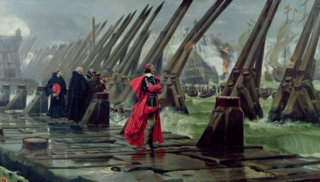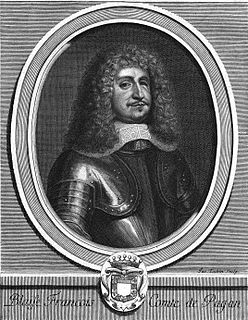
Louis XIII was King of France from 1610 to 1643 and King of Navarre from 1610 to 1620, when the crown of Navarre was merged with the French crown.

Philippe de Mornay, seigneur du Plessis Marly, usually known as Du-Plessis-Mornay or Mornay Du Plessis, was a French Protestant writer and member of the anti-monarchist Monarchomaques.

The siege of La Rochelle was a result of a war between the French royal forces of Louis XIII of France and the Huguenots of La Rochelle in 1627–28. The siege marked the height of the struggle between the Catholics and the Protestants in France, and ended with a complete victory for King Louis XIII and the Catholics.

Jacques-Nompar de Caumont, duc de La Force was a marshal of France and peer of France. He was the son of a Huguenot, Francois de Caumont, lord of Castelnau, and Philippe de Beaupoil. He survived the St. Bartholomew's Day Massacre in 1572, but his father and older brother Armand were killed.

The Recovery of Ré Island was accomplished by the army of Louis XIII in September 1625, against the troops of the Protestant admiral Soubise and the Huguenot forces of La Rochelle, who had been occupying the Island of Ré since February 1625 as part of the Huguenot rebellions.

The Anglo-French War was a military conflict fought between the Kingdom of France and the Kingdom of England between 1627 and 1629. It mainly involved actions at sea. The centrepiece of the conflict was the siege of La Rochelle (1627–28), in which the English crown supported the French Huguenots in their fight against the French royal forces of Louis XIII of France. La Rochelle had become the stronghold of the French Huguenots, under its own governance. It was the centre of Huguenot seapower and the strongest centre of resistance against the central government. The English also launched a campaign against France's new colony in North America which led to much of the territory including Quebec being seized.

The Naval battle of Saint-Martin-de-Ré took place on 27 October 1622, between the Huguenot fleet of La Rochelle under Jean Guiton, and a Royal fleet under Charles de Guise.

The Huguenot rebellions, sometimes called the Rohan Wars after the Huguenot leader Henri de Rohan, were a series of rebellions of the 1620s in which French Calvinist Protestants (Huguenots), mainly located in southwestern France, revolted against royal authority. The uprising occurred a decade after the death of Henry IV who, himself originally a Huguenot before converting to Catholicism, had protected Protestants through the Edict of Nantes. His successor Louis XIII, under the regency of his Italian Catholic mother Marie de' Medici, became more intolerant of Protestantism. The Huguenots tried to respond by defending themselves, establishing independent political and military structures, establishing diplomatic contacts with foreign powers, and openly revolting against central power. The Huguenot rebellions came after two decades of internal peace under Henry IV, following the intermittent French Wars of Religion of 1562–1598.

The siege of Saint-Jean-d'Angély was a siege, accomplished by the young French king Louis XIII in 1621, against the Protestant stronghold of Saint-Jean-d'Angély led by Rohan's brother Benjamin de Rohan, duc de Soubise. Saint-Jean-d'Angély was a strategic city controlling the approach to the Huguenot stronghold of La Rochelle.

The siege of Montauban was a siege conducted by the young French king Louis XIII from August to November 1621, against the Protestant stronghold of Montauban. This siege followed the siege of Saint-Jean-d'Angély, in which Louis XIII had succeeded against Rohan's brother Benjamin de Rohan, duc de Soubise.

The Blockade of La Rochelle took place in 1621-1622 during the repression of the Huguenot rebellion by the French king Louis XIII.

The Battle of Blavet was an encounter between the Huguenot forces of Soubise and a French fleet under the Duke of Nevers in Blavet harbour, Brittany in January 1625, triggering the Second Huguenot rebellion against the Crown of France.

The siege of Alès was undertaken by Louis XIII of France, and the city captured on 17 June 1629.

The siege of Privas was undertaken by Louis XIII of France from 14 May 1629, and the city of Privas was captured on 28 May 1629. It was one of the last events of the Huguenot rebellions (1621-1629).

The siege of Montpellier was a siege of the Huguenot city of Montpellier by the Catholic forces of Louis XIII of France, from August to October 1622. It was part of the Huguenot rebellions.
Events from the year 1629 in France.

Blaise François Pagan (1603–1665) was a French soldier and military engineer who served in the army of Louis XIII. His military career ended in 1642 when he lost his sight and in 1645, he published Les Fortifications; this became the dominant text of its era on military fortifications and significantly influenced Sébastien Le Prestre de Vauban.

François du Val, Marquis de Fontenay-Mareuil (fôNt′nā̇′mȧ′rẽ′y’) (c.1594-1665) was a French soldier, diplomat, and historian. He was brought up at the Court of Louis XIII.; served with Mayenne in Spain; with Nevers at Ratisbon; under Boisdauphin at the siege of Soissons (1617); in 1619 in Normandy; at Saint-Jean d'Angély, Clérac, and Montauban (1621); at Saint-Antoine and Montpellier (1622); at the Ile de Ré (1627); and at the sieges of La Rochelle (1628), of Privas, and of Alais (1629). Then his diplomatic career began. He announced the capture of La Rochelle to the Duke of Savoy; escorted Montpensier to the Court; negotiated with Rohan; and from 1630 to 1633 was Ambassador to England. After taking part in various campaigns against the Imperialists and Spaniards, he was Ambassador at Rome from 1640 to 1650. His memoirs, published at Paris, 1826, are both interesting and valuable.
Events from the year 1621 in France.
Events from the year 1622 in France.


















